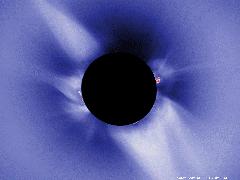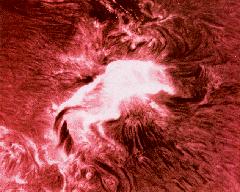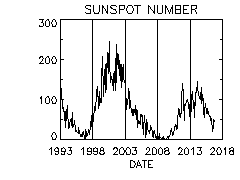 |
|
+ Home | ||

|
||||
| + Solar Cycle Prediction | + Magnetograph | + The Sun in Time | + The Hinode Mission | + The STEREO Mission |
The Big Questions
|
The Coronal Heating ProcessThe Sun's outer atmosphere (the Corona) is hotter than 1,000,000°C (1,800,000°F) while the visible surface has a temperature of only about 6000°C (10,000°F). The nature of the processes that heat the corona, maintain it at these high temperatures, and accelerate the solar wind is a third great solar mystery. Usually temperatures fall as you move away from a heat source. This is true in the Sun's interior right up to the visible surface. Then, over a relatively small distance, the temperature suddenly rises to extremely high values. Several mechanisms have been suggested as the source of this heating but there is no consensus on which one, or combination, is actually responsible. | ||
|
The Nature of Solar FlaresAreas on the Sun near sunspots often flare up, heating material to millions of degrees in just seconds and blasting billions of tons of material into space. The precise causes of solar flares and coronal mass ejections is another one of the great solar mysteries. Here again, we now know many details about these explosive events and we understand the basic mechanisms, but many details are missing. We still cannot reliably predict when and where a flare will occur or how big it will be. This problem is a little like trying to predict tornadoes. | ||
|
The Origin of the Sunspot CycleOver about 11 years the number of sunspots seen on the Sun increases from nearly zero to over 100 and then decreases to near zero again as the next cycle starts. The nature and causes of the sunspot cycle constitute one of the great mysteries of solar astronomy. While we now know many details about the sunspot cycle, (and also about some of the dynamo processes that must play key roles in producing it), we are still unable to produce a model that will allow us to reliably predict future sunspot numbers using basic physical principles. This problem is a little like trying to predict the severity of next year's winter or summer weather. | ||
|
The Missing NeutrinosThe Sun should produce more than twice as many neutrinos than are observed. These ghostly subatomic particles are released by nuclear reactions in the Sun's core. They then pass directly through the Sun and out into space. Detecting neutrinos is difficult, but the results from several independent experiments now confirm that only about a third of the expected numbers are counted here on Earth. Solar astronomers have attempted to alter their models of the Sun and its evolution over the last 4.5 billion years to make a model of the Sun that produces fewer neutrinos. These attempts have proven to be unsuccessful. This has led many scientists to question our understanding of neutrinos themselves. This final mystery may thus shake some of the foundations of Physics itself. |
June 5, 1998 - Neutrinos have mass! see:
http://www.phys.hawaii.edu/~jgl/neutrino_news.html
For more on neutrinos see:
http://www.physics.helsinki.fi/neutrino/
|
||||||||||||||||||||||||



